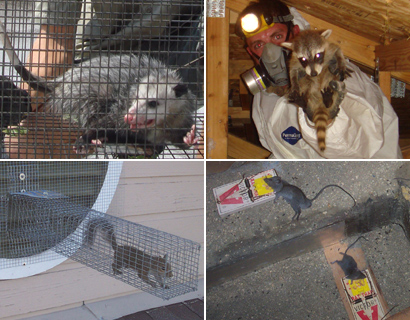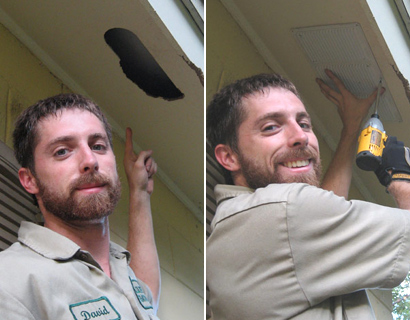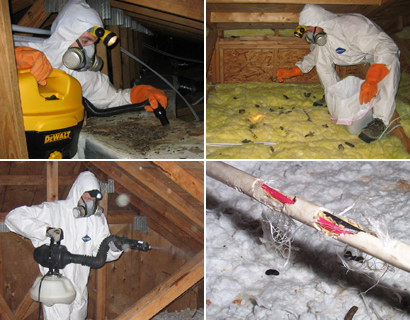- How We Solve Pennsylvania Wildlife Problems
How We Solve Harrisburg Wildlife Problems
INSPECTION: Once on site, we will perform a full inspection of your home and property. This allows us to use the correct strategy and traps. If the animals are in an attic, a full building inspection is crucial, including the following:
- All ground-level areas, such as piper or A/C line entry & exit areas, A/C chase bottoms, ground-level vents, etc.
- All mid-level areas, such as dryer vents, siding gaps, first floor eaves or dormers, etc.
- We inspect the entire roof, including all plumbing stacks, ridge caps, vents, and other potential gaps or holes.
- We also inspect inside your attic, to identify animals and damage they have caused.
- If the animals are outside, we notice many subtle clues that will assist us in a successful strategy.
TRAPPING, EXCLUSION, REMOVAL: Once we understand what animal species we are dealing with, and the problem, we use the most effective means of removing the animals. We use dozens of different types of traps.
- Trapping - If trapping the animal(s) in live cage traps, trap type, set, and location are crucial to success.
- Exclusion - Oftentimes, we are able to simply set one-way doors or other exclusion devices that allow the animals inside a building to safely exit, but never get back inside.
- Removal By Hand - Sometimes we actually remove animals by hand, or with special tools like snare poles.
- The Law - In all cases, we obey state and local laws regarding wildlife, but aim to take the most humane approach.
ENTRY HOLE REPAIRS: Repairs are a crucial step in the wildlife removal process. In many cases, such as bat or rodent control, the job cannot be performed without detailed repairs, and in all cases, sealing the entry holes shut ensures that no future wildlife will ever enter your home.
- 100% of the entry holes must be found, and sealed shut, or the job is not complete.
- Our repairs are professional contractor grade, look good, and when applicable we use steel, which rodents such as rats or squirrels are unable to chew through.
- We give a written guarantee on our repairs against any future animal entry.
ATTIC DECONTAMINATION SERVICES: It may be desirable to clean your attic after we've removed the animals. They can leave behind large amounts of droppings, urine, hair, oils, food, nesting material, and so on. These remnants can attract insects like cockroaches, and the scent left behind can encourage new animals to chew their way into your house. You might experience odor problems from the waste. It's possible that mold will grow on waste areas.
- We remove or vacuum all droppings, or remove all the soiled insulation.
- We fog the attic with a special enzyme-based cleaner that destroys any organic matter and deodorizes the space.
- We repair damage, such as ductwork, electrical wires, pipes, insulation, and more.
One of the biggest problems most Pennsylvania neighborhoods, as well as many neighborhoods nation wide, face is having to deal with is Raccoons! Raccoons are infamous for knocking over trashcans and rummaging through them for scraps of food. Wildlife such as raccoons becomes attracted to your area because of the garbage and then they end up staying on or close to your property to be closer to it's new found food source. This problem is one of the many problems we are able to solve. Whether it's trapping and removing the problem or making necessary repairs to your property to keep them out and keep your family and pets safe. We service Harrisburg, Pennsylvania, as well as the following cities and counties; if you do not see your area listed please give us a call!
-Progress -Colonial Park -Chambersburg -Carlisle -Elizabethtown -Ephrata
-Sunbury -Lebanon -Columbia -Hanover -York -Lancaster -Pottsville -Hershey
-Cumberland County
-Perry County
-Lebanon County
-Adams County
-York County
Other Harrisburg animal pest control topics:
How to Trap a Shy Rat
Do Bats Reside in Urban Areas
What are Symptoms of a Sick Opossum
How to Relocate a Skunk
To learn more about our services, visit the Harrisburg wildlife control home page.
This month's wildlife how-to article: What is am Opossum’s Natural Diet, and how does it get it's Food?
What is am Opossum’s Natural Diet, and how does it get it's Food?
Habitat
Before we get into how an opossum’s natural diet is, we have to understand what they habitat is like as this will generally dictate what they eat in the wild. Opossums are found all across the United States and in most states but the most arid of regions. They even go so far as the southern parts of Canada! Because of this, opossums have learned to adapt to their diets and now eat just about anything. They are extremely good at scavenging for food and go to great lengths to get food if need be.
The Scavenging Omnivore
Opossums are not picky eaters. In fact, the will go about eating just about anything. That is why they can adapt so well to urban areas because they will just go through your garbage eating whatever they can find there! However, in the wild they will often feed on certain creatures and plant life available in the area such as:
-Amphibians
-Beetles
-Birds (of the small variety)
-Centipedes
-Carrion
-Cockroaches
-Earthworms
-Eggs
-Fruits (especially berries)
-Leaves
-Larvae
-Mice
-Mushrooms
-Rats
-Slugs and snails
-Snakes (yes,even snakes such as rattlesnakes and cottonmouths)
-Vegetables
How do they eat?
As you very well know by now, opossums will eat just about anything and that’s why they are so proliferous. However, it’s not just the non-picky-eater lifestyle that makes them able to thrive. They get a little help from their physical attributes such as their:
-Prehensile tail
-Opposable “thumbs”
Let’s talk first about their tail. These prehensile tails allow them to obtain food even in the most difficult and out of reach places with ease. This tail is not like any normal tail as it is like a hand of sorts for them. They can grab and grasp food with their tail or use the tail to balance or help climb up to wherever the food is. As for their “thumbs”, these are found on their finger-like rear feat and they can also use these to grasp and grab items as they forage for food.
When do they eat?
Though opossums will very much eat anything, the types of food that they can eat do depend on the seasons. For instance, in the fall and winter months, opossums are more likely to eat:
-Blackberries
-Tomatoes
-Persimmons
-Acorns
While during the warmer months, opossums will choose to eat:
-Insects
-Larvae





